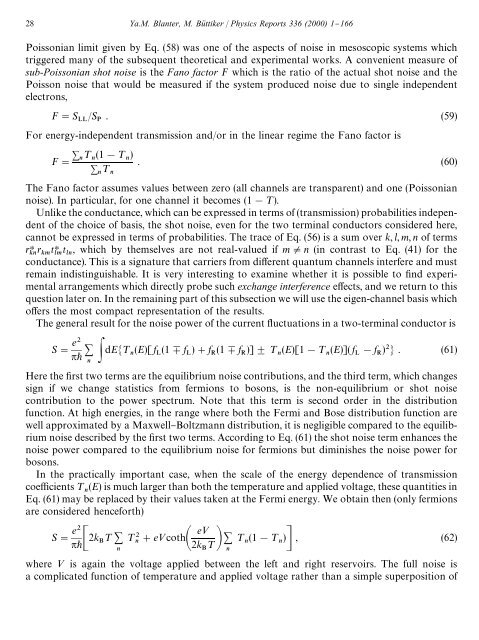shot noise in mesoscopic conductors - Low Temperature Laboratory
shot noise in mesoscopic conductors - Low Temperature Laboratory
shot noise in mesoscopic conductors - Low Temperature Laboratory
You also want an ePaper? Increase the reach of your titles
YUMPU automatically turns print PDFs into web optimized ePapers that Google loves.
28 Ya.M. Blanter, M. Bu( ttiker / Physics Reports 336 (2000) 1}166<br />
Poissonian limit given by Eq. (58) was one of the aspects of <strong>noise</strong> <strong>in</strong> <strong>mesoscopic</strong> systems which<br />
triggered many of the subsequent theoretical and experimental works. A convenient measure of<br />
sub-Poissonian <strong>shot</strong> <strong>noise</strong> is the Fano factor F which is the ratio of the actual <strong>shot</strong> <strong>noise</strong> and the<br />
Poisson <strong>noise</strong> that would be measured if the system produced <strong>noise</strong> due to s<strong>in</strong>gle <strong>in</strong>dependent<br />
electrons,<br />
F"S /S . (59)<br />
<br />
For energy-<strong>in</strong>dependent transmission and/or <strong>in</strong> the l<strong>in</strong>ear regime the Fano factor is<br />
F" ¹ (1!¹ )<br />
. (60)<br />
¹<br />
<br />
The Fano factor assumes values between zero (all channels are transparent) and one (Poissonian<br />
<strong>noise</strong>). In particular, for one channel it becomes (1!¹).<br />
Unlike the conductance, which can be expressed <strong>in</strong> terms of (transmission) probabilities <strong>in</strong>dependent<br />
of the choice of basis, the <strong>shot</strong> <strong>noise</strong>, even for the two term<strong>in</strong>al <strong>conductors</strong> considered here,<br />
cannot be expressed <strong>in</strong> terms of probabilities. The trace of Eq. (56) is a sum over k, l, m, n of terms<br />
rH r tH t , which by themselves are not real-valued if mOn (<strong>in</strong> contrast to Eq. (41) for the<br />
<br />
conductance). This is a signature that carriers from di!erent quantum channels <strong>in</strong>terfere and must<br />
rema<strong>in</strong> <strong>in</strong>dist<strong>in</strong>guishable. It is very <strong>in</strong>terest<strong>in</strong>g to exam<strong>in</strong>e whether it is possible to "nd experimental<br />
arrangements which directly probe such exchange <strong>in</strong>terference e!ects, and we return to this<br />
question later on. In the rema<strong>in</strong><strong>in</strong>g part of this subsection we will use the eigen-channel basis which<br />
o!ers the most compact representation of the results.<br />
The general result for the <strong>noise</strong> power of the current #uctuations <strong>in</strong> a two-term<strong>in</strong>al conductor is<br />
S" e<br />
dE¹ (E)[ f (1Gf )#f (1Gf )]$¹ (E)[1!¹ (E)]( f !f ) . (61)<br />
<br />
Here the "rst two terms are the equilibrium <strong>noise</strong> contributions, and the third term, which changes<br />
sign if we change statistics from fermions to bosons, is the non-equilibrium or <strong>shot</strong> <strong>noise</strong><br />
contribution to the power spectrum. Note that this term is second order <strong>in</strong> the distribution<br />
function. At high energies, <strong>in</strong> the range where both the Fermi and Bose distribution function are<br />
well approximated by a Maxwell}Boltzmann distribution, it is negligible compared to the equilibrium<br />
<strong>noise</strong> described by the "rst two terms. Accord<strong>in</strong>g to Eq. (61) the <strong>shot</strong> <strong>noise</strong> term enhances the<br />
<strong>noise</strong> power compared to the equilibrium <strong>noise</strong> for fermions but dim<strong>in</strong>ishes the <strong>noise</strong> power for<br />
bosons.<br />
In the practically important case, when the scale of the energy dependence of transmission<br />
coe$cients ¹ (E) is much larger than both the temperature and applied voltage, these quantities <strong>in</strong><br />
<br />
Eq. (61) may be replaced by their values taken at the Fermi energy. We obta<strong>in</strong> then (only fermions<br />
are considered henceforth)<br />
S" e<br />
2k e<<br />
¹ ¹#e
















